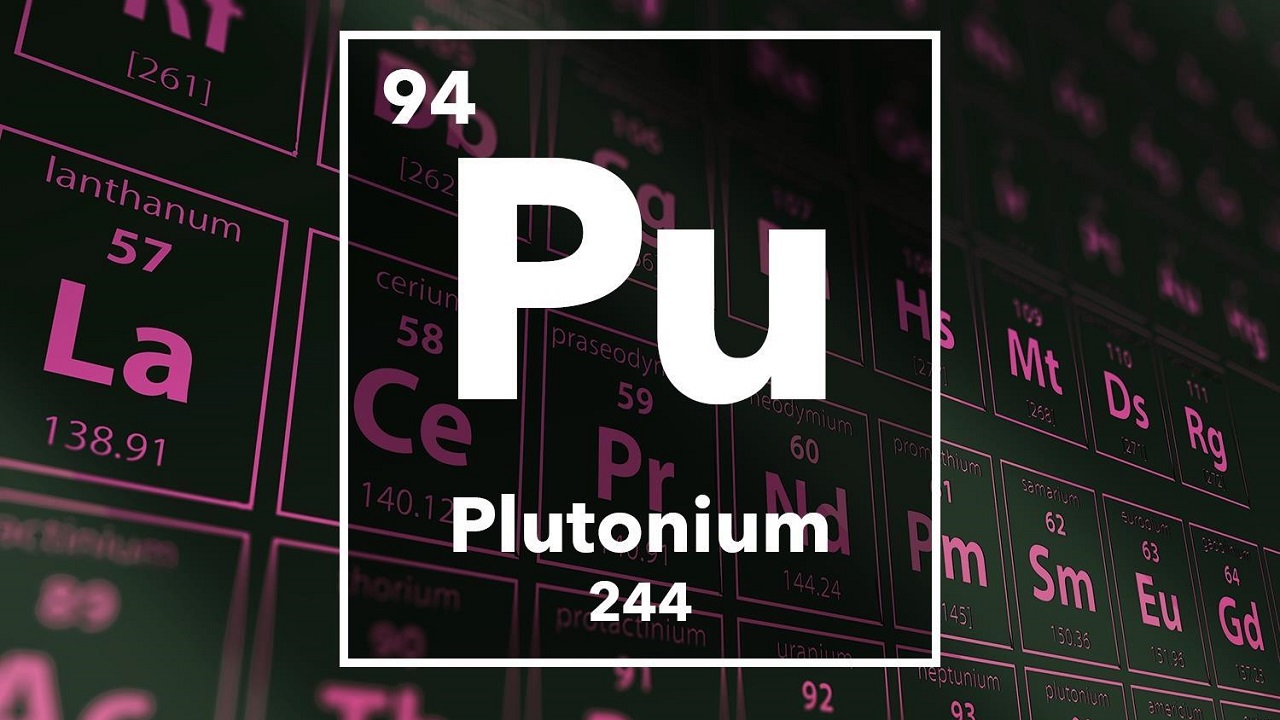
What is Plutonium? Electron configuration, Atomic Number & Mass, Uses
Plutonium is a chemical element with the number 94 in the Periodic Table of the Elements.
|
General informations |
|
|
Symbol |
Pu |
|
Atomic number |
94 |
|
Family |
Actinide |
|
Period |
7 |
|
Bloc |
f |
|
Volumic mass |
19816 kg.m-3 |
|
Color |
Blanc |
|
Atomic properties |
|
|
Atomic mass |
244,06 у |
|
Atomic radius |
159 pm |
|
Electronic configuration |
[Rn] 7s2 5f6 |
|
Electrons by energy level |
2 | 8 | 18 | 32 | 24 | 8 | 2 |
|
Oxide |
Amphotère |
|
Physical properties |
|
|
Ordinary state |
Solid |
|
Fusion point |
640 °C |
|
Boiling point |
3228 °C |
A bit of history around element 94
Etymology
The name of plutonium is a reference to the planet Pluto. It was named so since Pluto is the planet that follows Neptune in the solar system, just as plutonium follows neptunium.
Discovery of plutonium
Plutonium was first synthesized in 1940 at the University of California at Berkeley. This discovery came after the bombardment of a source of uranium 238 with deuterium.
Researchers at the University of California at Berkeley isolated it during their research on the A bomb, in the context of the world war. This is why the existence of element 94 will not be published until 1942.
Know About Radon
Presence in the natural state of simple plutonium
Since plutonium is a synthetic element, it is not present in the natural state and the only plutonium resources come from the production carried out in laboratories.
However, it is possible to find tiny traces of it in ores that contain uranium.
Plutonium is one of the least present elements on the Earth's surface, so its clarke is very low.
Plutonium production
About thirty kilograms of plutonium are produced per year. The majority of plutonium 239 is produced.
To produce it, nuclear reactors are used in which uranium-238 is irradiated.
Today, there are world stocks of plutonium, all isotopes combined, at 500 tons according to this distribution:
-
Russia with 178 tons,
-
The United Kingdom with 107 tons,
-
The United States with 88 tons,
-
France with 66 tons,
-
Japan with 48 tons,
-
The rest of the world shares the remaining 13 tons.
Physical and chemical properties of simple plutonium and its compounds
Plutonium is an element that is part of the actinide family.
It is a weak electrical and thermal conductor. However, its ability to retain heat, called heat capacity, is important.
In contact with air, plutonium becomes covered with a layer of plutonium dioxide, which appears grayish.
Most of the radioactive isotopes of plutonium decay into alpha decays.
However, there are some, such as plutonium 240 for example, which decay by beta radioactivity.
The different isotopes of plutonium
To date, 20 isotopes of plutonium are known, their mass numbers varying from 228 to 247.
It also has 7 nuclear isomers.
All of its isotopes are radioactive.
Its most stable isotope with the longest half-life is plutonium 244 which has a half-life of 8x10 7 years while the one with the smallest half-life is plutonium 239 with a half-life. half-life of 193 ns.
Plutonium alloys
We can find plutonium in alloy with a multitude of other metals:
- Plutonium-gallium alloy,
- The plutonium-uranium alloy,
- The plutonium-zirconium-uranium alloy,
- Plutonium-aluminum alloy,
- The plutonium-cerium alloy,
- L'alliage plutonium-gallium-cobalt
- The plutonium-uranium-thorium alloy.
Uses of plutonium
Plutonium has many applications, whether in the field of civil or military.
Plutonium in medicine
The isotope plutonium 238 is used in pacemakers as a source of energy. It has since been replaced by lithium batteries.
Plutonium in industry
In nuclear power plants, used nuclear fuel is partly composed of plutonium, different isotopes. In this state, the mixture is no longer enriched enough in plutonium to be able to use it again.
It is therefore necessary to store these products in the form of long-lived radioactive waste.
Plutonium and the military
In the field of nuclear weapons, plutonium-239 is regularly used because it is easy to find and use.
For example, the Fat Man bomb dropped on Nagasaki in 1945 is composed of more than 6 kg of a plutonium-gallium alloy.
Plutonium in space missions
Thanks to the strong radioactive energy that it releases, plutonium 238 is used as nuclear fuel in space probes in particular.
Famous space probes have used this isotope of plutonium which has a half-life of 87 years for their operation. This is the case with Voyager, Galileo, Curiosity and even Cassini-Huygens.
Element 94 Dangers
Plutonium is a very dangerous element. This toxicity varies somewhat according to its isotopes but in all cases, the radioactivity of this element exposes the person who handles it to a violent acute radiation syndrome.
Produced for its radioactive characteristics, plutonium is however very dangerous, because of its radioactive emissions of alpha, beta or gamma radiation.
A 1969 study showed that ingesting even one millionth of plutonium could be fatal. Because of its high radioactivity, it is necessary to limit the releases of this element which can be considered as ecotoxic.
If it is absorbed by the body, it is fixed in the liver and in the bones, causing serious irradiation or cancer, such as lung or liver cancer for example.
Prevention around plutonium
Treaties have been put in place in many countries to prevent the proliferation of plutonium. Indeed, it can be used for terrorist purposes. This is why the International Atomic Energy Agency has placed all the isotopes of plutonium as a material directly usable for nuclear purposes.
Know about more periodic elements- Gadolinium, Germanium, Neon, Oxygen, Potassium, Promethium, Selenium, Sodium, Terbium, Tellurium, Yttrium, Ytterbium, Zirconium
Related Articales
Recently Posted
-
भगवान गौतम बुद्ध जीवन परिचय | Gautam Buddha in Hindi
December 15, 2022. -
कार्बन के अपररूप Allotropes of Carbon in Hindi
November 5, 2022. -
मिश्र धातु किसे कहते हैं? उपयोग, नाम, गुण Alloy in Hindi
July 27, 2022. -
गलनांक किसे कहते हैं? परिभाषा, उदाहरण Melting Point in Hindi
July 20, 2022. -
परिमाप किसे कहते हैं? Perimeter in Hindi
July 19, 2022.




